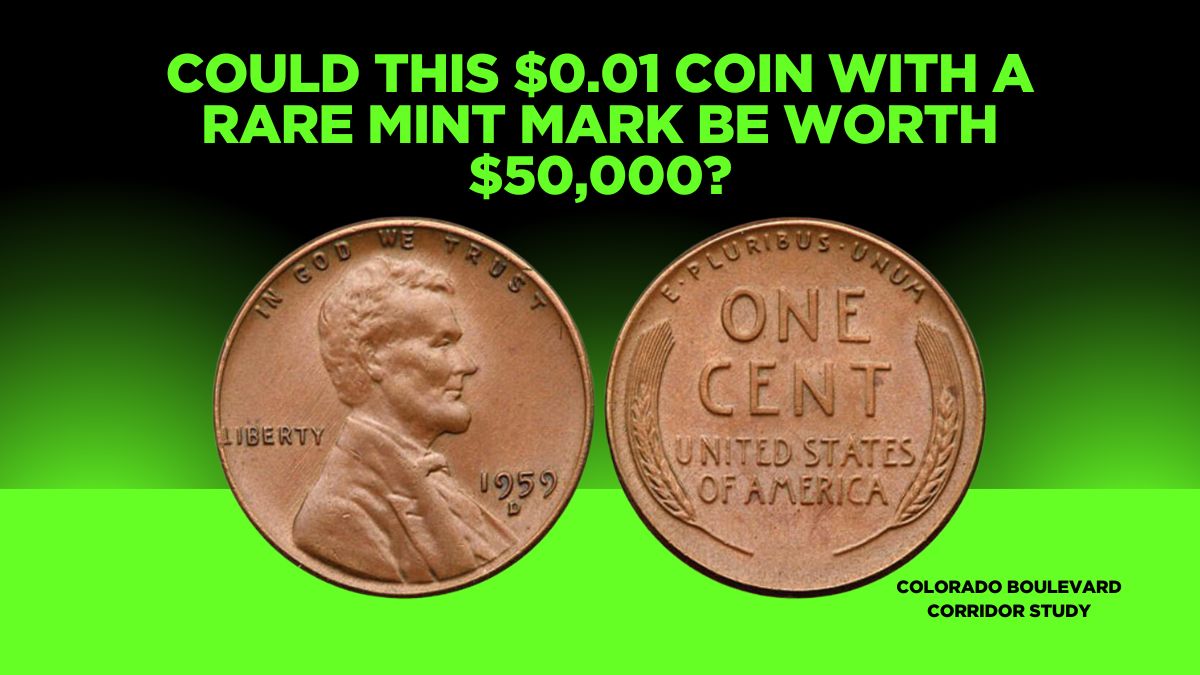The world of coin collecting is filled with fascinating stories of seemingly ordinary coins turning out to be worth small fortunes. One such intriguing tale involves a humble 1-cent coin that, due to a rare mint mark and unique characteristics, could be valued at $50,000 or more.
This article delves into the specifics of this rare penny, exploring its history, distinguishing features, and the factors contributing to its extraordinary value.
The 1959-D Lincoln Wheat Penny Mule Error
In 1959, the U.S. Mint transitioned from the Lincoln Wheat reverse design (wheat ears) to the Lincoln Memorial reverse design. However, a rare error coin known as the 1959-D Lincoln Wheat Penny Mule Error features the obverse of a 1959 Lincoln cent paired with the reverse of a pre-1959 wheat penny.
This anomaly is termed a “mule” error, referring to a coin struck with mismatched dies.
Key Features of the 1959-D Mule Error Penny
- Obverse: Standard 1959 Lincoln cent design with the “D” mint mark denoting the Denver Mint.
- Reverse: Wheat ears design used prior to 1959, instead of the expected Lincoln Memorial.
- Composition: 95% copper, 5% tin and zinc.
- Weight: Approximately 3.11 grams.
The existence of this coin has been a subject of debate among numismatists. While some experts question its authenticity, citing the possibility of a well-executed counterfeit, others believe it to be a genuine mint error.
The coin has reportedly been sold in private transactions for amounts exceeding $50,000, though its legitimacy remains controversial.
Factors Contributing to the High Value
Several elements contribute to the potential high value of the 1959-D mule error penny:
- Rarity: As of now, only one specimen is known to exist, making it exceptionally rare.
- Historical Significance: The coin represents a unique error during a transitional period in U.S. coinage design.
- Collector Demand: Error coins, especially mule errors, are highly sought after by collectors due to their uniqueness and rarity.
Other Valuable Lincoln Pennies
While the 1959-D mule error penny is unique, other Lincoln pennies with specific mint marks and errors have also fetched impressive sums at auctions. Below is a table highlighting some of these notable coins:
| Year | Mint Mark | Error/Variety | Estimated Value |
|---|---|---|---|
| 1943 | D | Bronze Planchet | $2.3 million |
| 1969 | S | Doubled Die Obverse | $126,500 |
| 1983 | None | Copper Planchet | $15,000 – $20,000 |
| 1992 | D | Close AM Reverse | $500 |
| 1995 | D | Doubled Die Obverse | $50 |
Note: Values are approximate and can vary based on the coin’s condition and market demand.
Identifying Rare Pennies in Your Collection
To determine if you possess a valuable penny, consider the following steps:
- Examine the Date and Mint Mark: Look for key dates and mint marks known for rare errors or low mintage numbers.
- Inspect for Errors: Use a magnifying glass to identify anomalies such as doubled dies, off-center strikes, or incorrect planchets.
- Weigh the Coin: Certain errors involve coins struck on planchets with incorrect weights. A precise scale can help detect such discrepancies.
- Consult a Professional: If you believe you have a rare coin, seek verification from a reputable coin grading service or numismatic expert.
Frequently Asked Questions (FAQs)
1. What is a mule error in coinage?
A mule error occurs when a coin is struck with obverse and reverse dies that were not intended to be paired together, resulting in a coin with mismatched designs.
2. How can I verify the authenticity of a rare penny?
Consult a reputable coin grading service or numismatic expert who can assess the coin’s authenticity through physical examination and testing.
3. Are all error pennies valuable?
Not all error pennies are valuable. The value depends on the rarity, demand, and significance of the error. Common errors may have minimal value, while rare errors can be worth substantial amounts.
4. Where can I sell a rare penny?
Rare pennies can be sold through coin dealers, auctions, or online marketplaces specializing in numismatics. It’s advisable to have the coin authenticated and graded to maximize its value.
5. What should I do if I find a penny with a potential error?
Avoid cleaning or altering the coin. Store it safely and seek evaluation from a professional to determine its authenticity and value.
In conclusion, while the notion of a $0.01 coin being worth $50,000 may seem improbable, the world of coin collecting is full of such possibilities. Rare errors, unique mint marks, and historical significance can elevate the value of certain pennies far beyond their face value. Diligent examination and consultation with experts are key to uncovering these hidden treasures.

